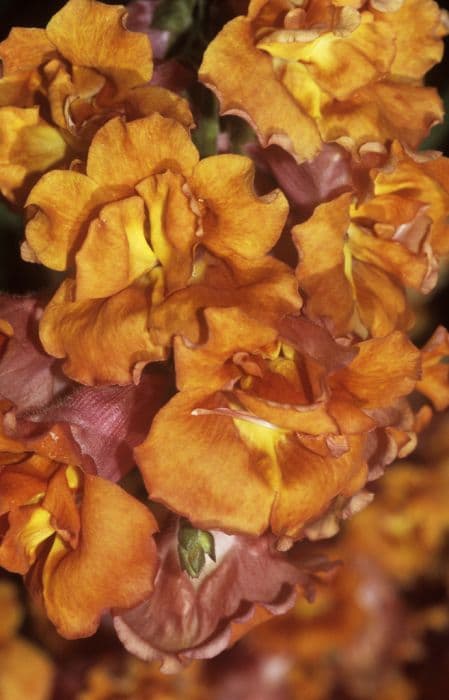Autumnal Water Starwort Callitriche hermaphroditica
ABOUT
Callitriche hermaphroditica, commonly known as autumnal water-starwort, is an aquatic or semi-aquatic plant with a unique and quite modest appearance. It thrives in freshwater environments and has adapted to both submerged and emergent conditions. The leaves of the autumnal water-starwort are quite delicate and small, typically forming in opposite pairs along the stem. They exhibit a variable shape that can range from linear to spatulate, sometimes appearing more rounded when the plant is floating. The colors of the leaves can provide a visual cue to the health and location of the plant. Underwater leaves tend to be slender and translucent, while those at the surface may be broader and sport a more vibrant green hue. The autumnal water-starwort has a stem that is thin and can branch out, either floating or creeping depending upon the water depth and the plant's position relative to the water surface. Flowers of this plant are inconspicuous and small, usually with greenish or whitish tones, and they grow at the leaf axils. The reproductive parts are contained within the flower, which typically does not catch attention easily due to its subtle size and coloration. The plant produces fruits that are small and hard, aiding in its propagation and survival within its aquatic habitat. Overall, the autumnal water-starwort has a simple, unassuming appearance, blending seamlessly with the aquatic environments it inhabits. Its ability to adapt to various water depths allows for subtle variations in its appearance that are largely driven by the availability of light and the presence of water.
About this plant
 Names
NamesFamily
Plantaginaceae
Synonyms
Autumnal Water-starwort, Hermaphrodite Water-starwort
Common names
Callitriche hermaphroditica.
 Toxicity
ToxicityTo humans
There is limited information specifically about the toxicity of Water Starwort (Callitriche hermaphroditica) to humans. To provide accurate and safe information, it is recommended to avoid ingestion of any plant parts unless it’s known to be safe. If you suspect poisoning from any plant, contact a medical professional or poison control center immediately.
To pets
Similarly, there's scarce information on the effects of Water Starwort (Callitriche hermaphroditica) on pets. As a precautionary measure, prevent pets from ingesting unknown plant species, and in case of suspected poisoning, consult a veterinarian. Monitoring pets for any signs of distress after ingestion—including gastrointestinal upset or abnormal behavior—is advisable, and immediate veterinary attention should be sought if symptoms arise.
 Characteristics
CharacteristicsLife cycle
Perennials
Foliage type
Deciduous
Color of leaves
Green
Height
0 inches (0 cm)
Spread
6 inches (15 cm)
Plant type
Herb
Hardiness zones
5
Native area
Europe
Benefits
 General Benefits
General Benefits- Ecosystem support: Callitriche hermaphroditica, commonly known as Autumnal Water-starwort, provides an important habitat for aquatic and semi-aquatic wildlife, offering shelter and breeding grounds for invertebrates, amphibians, and fish.
- Biodiversity enhancement: By adding structural complexity to aquatic environments, Autumnal Water-starwort supports a diverse range of aquatic organisms, which contributes to overall ecosystem health and resilience.
- Water quality improvement: The plant helps in stabilizing sediments and can take up nutrients from the water, which can help in reducing excess nutrients that might otherwise lead to problems like algal blooms.
- Soil erosion control: The root systems of Autumnal Water-starwort help to bind soil and sediments along water bodies, minimizing erosion and maintaining banks and shorelines.
- Oxygenation of water: Like many aquatic plants, the photosynthetic activity of Autumnal Water-starwort adds dissolved oxygen to the water, which is crucial for aquatic life.
- Food source: The plant serves as a source of food for a variety of aquatic creatures, including insects and some species of waterfowl, which graze on it.
- Aquascaping and ornamental use: Autumnal Water-starwort can be used in ponds and aquariums for its aesthetic qualities, contributing to the visual appeal and natural feel of aquascapes.
 Medical Properties
Medical PropertiesThis plant is not used for medical purposes.
 Air-purifying Qualities
Air-purifying QualitiesThis plant is not specifically known for air purifying qualities.
 Other Uses
Other Uses- Water Garden Decoration: Callitriche hermaphroditica can be used to create visual interest in water gardens or ponds due to its growth pattern and the way it floats on the water surface.
- Biological Indicator: Because of its sensitivity to certain pollutants, it can serve as an indicator of water quality in freshwater ecosystems.
- Erosion Control: The plant can help to stabilize the soil and prevent erosion around pond banks and in streams due to its rooting system.
- Wildlife Habitat: It provides a habitat and breeding ground for various aquatic invertebrates, which are crucial for a healthy aquatic food chain.
- Oxygenation: Though not for air purification, it contributes to the oxygenation of water, making it beneficial for fish and other aquatic organisms.
- Aquatic Feed: Some species of waterfowl and other aquatic animals feed on Callitriche hermaphroditica, offering a natural food source.
- Nursery for Fish: Young fish and amphibians use the dense mats of this plant as a nursery to hide and protect themselves from predators.
- Photography Subject: Due to its interesting texture and formation, it is used by photographers as a subject for artistic nature photography, especially macro-photography.
- Educational Tool: This plant can be used in classroom settings to demonstrate plant life cycles and aquatic plant care to students.
- Aquaculture: Callitriche hermaphroditica can be integrated into aquaculture systems to enhance water quality and provide a natural environment for farmed aquatic species.
Interesting Facts
 Feng Shui
Feng ShuiThe Water Starwort is not used in Feng Shui practice.
 Zodiac Sign Compitability
Zodiac Sign CompitabilityThe Water Starwort is not used in astrology practice.
 Plant Symbolism
Plant SymbolismUnfortunately, there is limited specific symbolic information available about Callitriche hermaphroditica, commonly known as autumnal water-starwort. This plant does not have a widely recognized set of symbolic meanings like those associated with more commonly known flowers such as roses or lilies. Generally, water plants can symbolize flexibility, adaptation, and purity, as they often inhabit and cleanse their aquatic environments. For a precise symbolism of autumnal water-starwort, one might need to look into the specifics of its ecology, cultural context, or personal sentiment.
 Water
WaterThe most common name for Callitriche hermaphroditica is Starwort, and it thrives in consistently moist conditions. Water Starwort by submerging the pot in water or by maintaining a water level around the plant base, replicating its natural aquatic habitat. Ensure there is always at least an inch of water covering the soil or growth medium. The frequency of watering should be adjusted to replenish the evaporated water, typically once every week, adding about a gallon of water to maintain the required water level.
 Light
LightStarwort grows best in full sun to partial shade. The ideal spot for this plant would be an area that receives a few hours of direct sunlight but is also partly shielded from the intense midday sun. An east or west-facing position by a pond or water feature can provide the best balance of light conditions.
 Temperature
TemperatureStarwort, or Callitriche hermaphroditica, prefers temperate climates. The ideal temperature range for growing Starwort is between 50°F and 77°F. It can survive in temperatures as low as 32°F and as high as 86°F, but it is essential to avoid freezing conditions and extremely hot temperatures to prevent damage to the plant.
 Pruning
PruningPruning Starwort is generally not necessary as it naturally maintains a compact form. However, if you wish to manage its spread or remove yellowed leaves, pruning can be done carefully with scissors, trimming back as needed. The best time for pruning Starwort is during the spring or summer months when the plant is actively growing. Pruning can be done every few months or as often as needed to maintain the desired shape and size.
 Cleaning
CleaningAs needed
 Soil
SoilWater Starwort thrives best in a semi-aquatic environment with a neutral to slightly acidic pH, ideally between 6.0 and 7.0. For optimal growth, a loose, sandy loam or a mix with plenty of perlite or vermiculite is suitable, ensuring good drainage while retaining moisture.
 Repotting
RepottingWater Starwort typically does not require frequent repotting. It can be left undisturbed unless the plant outgrows its container or the soil needs refreshing. Repot approximately every 2-3 years or as necessary for maintaining health.
 Humidity & Misting
Humidity & MistingWater Starwort best grows at high humidity levels, often close to 100% due to its semi-aquatic nature. It is most successful when grown in environments that replicate its natural wetland habitat.
 Suitable locations
Suitable locationsIndoor
Place in bright indirect light, keep soil moist.
Outdoor
Choose sunny to part-shady spot, keep wet.
Hardiness zone
4-7 USDA
 Life cycle
Life cycleCallitriche hermaphroditica, commonly known as Autumnal Water-starwort, begins its life as a seed, typically germinating under water in muddy substrates during the spring. After germination, the seedling develops into a juvenile plant, characterized by its rapid vegetative growth and the formation of a rosette of submerged leaves. As the plant matures, it produces both floating and submerged leaves, adapting to varying water levels, and it enters the reproductive phase, developing small, inconspicuous flowers that contain both male and female reproductive structures. Pollination occurs, often facilitated by water movement, leading to the production of fruits that eventually release seeds once mature. These seeds enter a dormant phase, especially over winter, enduring until conditions are favorable for the next cycle of germination. Throughout its life, the plant can also reproduce vegetatively through stem fragments that break off and root, forming new individuals.
 Propogation
PropogationPropogation time
Spring-early summer
Callitriche hermaphroditica, commonly known as Autumnal Water-starwort, can be propagated most effectively through seed dispersal which usually takes place in the fall. To propagate this plant, allow the mature seeds to fall naturally into the water or substrate where they can germinate. In an aquatic environment, simply scattering the seeds over the water surface can allow them to sink and establish roots. The seeds typically require cold stratification, a period of cold temperature to break dormancy, so providing a winter season or a simulated cold period is essential for successful germination. Keep the substrate or the water slightly disturbed to mimic the natural flow that would bury seeds in their native habitat. This method closely imitates the natural conditions under which Autumnal Water-starwort thrives and is the most straightforward and commonly used technique for propagation of this species.


![Foxglove [Illumination Ruby Slippers]](/_next/image?url=https%3A%2F%2Fplants-admin.emdemapps.com%2Fimages%2Fplants%2F%2Fimages%2F604b5cbc93f0b.png&w=640&q=75)
![Hebe [Garden Beauty Purple]](/_next/image?url=https%3A%2F%2Fplants-admin.emdemapps.com%2Fimages%2Fplants%2F%2Fimages%2F604b646a3d922.png&w=640&q=75)



![Penstemon [Phoenix Appleblossom]](/_next/image?url=https%3A%2F%2Fplants-admin.emdemapps.com%2Fimages%2Fplants%2F%2Fimages%2F604b553795aab.png&w=640&q=75)

